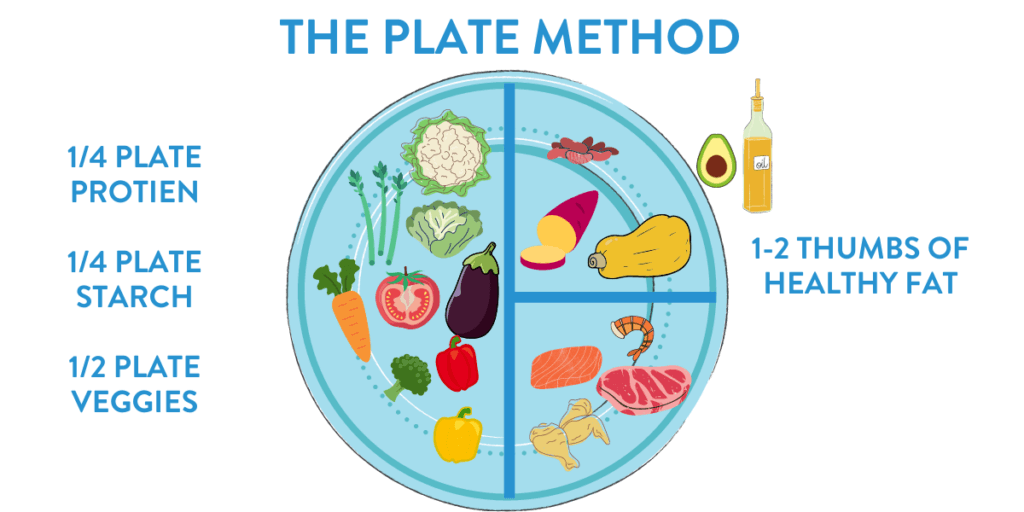I am unable to count on both hands the number of times a client has said to me that they have “hit a weight loss plateau”. Or, that their metabolic rate is “stuck” and their metabolism is “messed up”.
The fact of the matter is that weight loss plateaus happen. It’s a normal occurrence in the weight loss process. Most of the time weight loss isn’t linear. A person will begin losing weight quickly initially, then it will taper off. They may stay at that weight for a short while, or even gain a bit back before they plunge down in weight again.
But, there is no doubt that when you have a client on a weight loss journey who is doing really well, then all of a sudden the weight loss stops, it can be very frustrating for both you.
If you are a nutrition coach looking to help clients shed pounds and troubleshoot a weight loss plateau, then this article is for you!
If you are an aspiring nutrition coach and would like to find out more information on how to get certified – book a no strings attached free call with us!

What Is A Weight Loss Plateau?
A weight loss plateau is a state of little or no change after a time of activity or progress, typically six weeks. It’s important to know that there are many reason’s why someone may hit a weight loss plateau. For clients who truly are consistent and sticking to the plan, the plateau occurs because the body adapts to the changes made in diet and exercise, and the metabolism slows down to compensate for the reduced caloric intake. As a result, the body burns fewer calories, and weight loss slows down or stops altogether.
Clients who experience this often want to go on a low calorie diet and drastically reduce their food intake. This is not the solution. Doing so will only slow the metabolic rate even more, and deplete the body’s ability for energy expenditure. The fix in this situation would be to change up the exercise routine by adding more strength training, resistance training, and adjusting the calories to fit new energy expenditure.
For some clients, the solution is not that simple. Many tell you they are consistent, but no matter how much you change up their exercise program or calorie intake, body composition changes still don’t happen. This is very frustrating for both the coach and the client.
We wrote this article to help you as a nutrition coach troubleshoot a weight loss plateau. So let’s get right into it.
How To Troubleshoot A Weight Loss Plateau
Troubleshooting a weight loss plateau can help your client overcome the obstacles that are preventing them from reaching their goal weight, and it can help them stay motivated. If they float along thinking they are doing everything they can and are stuck at this weight forever, the feeling of failure sets in. But, your role as the nutrition coach is to dig a bit deeper by asking some thought provoking questions and assessing the entire holistic framework.

Step #1 - Reassess
Reassessing your clients baseline should be your first step! Remember back in the beginning of their program when you did their initial consult? You established their baseline. Over time a new baseline was set which elicited some weight loss. Find out how that baseline has changed.
Has their daily intake changed recently? Don’t take no as the final answer. Ask about their coffee creamer, and what they eat for lunch and dinner. Dig a little deeper than just accepting no.
Has their fitness changed?
Have they had a recent change in their routine overall?
Now is also a great time to reassess goals and establish their why. Why is it important for them to have this weight loss goal? How will they see themselves after they reach that goal? How will they feel if they give up on reaching their goal. How will losing weight affect the way they interact with others? Will people see them differently if they lose weight? If so, how?
Make sure that your client has realistic expectations when it comes to their goal. Always remember to remind them that the goal is to lose weight slowly maintaining about a pound per week.

Step #2 - Assess Consistency & Troubleshoot
Consistency over time equals results. We’ve all heard it and it’s true! We all need to be consistent if we want to see results. Now is the time for you to talk about consistency with your client.
Are they consistently completing their action steps from your checkins
Have their foundational habits stuck? Meaning the habits you taught them in the beginning to get to the point of weight loss, are they still practicing those habits? If so – consistently?
Has an event occurred in their life that is wreaking havoc on them or is something bothering them they may not immediately recognize.
Some things consistency really matters with are things like meal prep, prioritizing the plate method or hand portion guides, and drinking enough water. Many times women struggle to get in enough protein! Dig deep here by asking a ton of questions! Your client may think they are doing all the right things to lose body weight and eat a healthy diet. But, by you asking a lot of questions you may uncover some missed points.
Step #3 - Use A Holistic Approach
The foundation of the HSN nutrition coaching platform is built on taking a holistic approach to nutrition coaching.
Here are the holistic pillars we consider with all of our clients:
Sleep
Did you know that lack of sleep can drastically effect a clients weight loss efforts?
Here are some ways it can affect weight loss:
Decreased metabolism:
Sleep deprivation can slow down the metabolism and make it more challenging for the body to burn calories. This means that even if a person is eating the same amount of food and exercising as usual, they may not be able to lose weight as efficiently as they could if they were getting enough sleep.
Increased hunger and cravings:
Lack of sleep can increase the production of the hunger hormone ghrelin and decrease the production of the satiety hormone leptin. This can lead to an increase in appetite and cravings for high-calorie foods, which can make it more difficult to stick to a healthy diet and lose weight.
Impaired glucose metabolism:
Sleep deprivation can impair glucose metabolism, leading to insulin resistance and higher blood sugar levels. This can make it more difficult for the body to burn fat and lead to weight gain.
Decreased energy and motivation:
Lack of sleep can lead to decreased energy and motivation to exercise, which can further impede weight loss efforts.

Stress level and stress management
Depending on your clients stress level and how they manage stress will determine if they need to make any changes here. A stress management program may not be out of the question.
Stress can have huge ramifications and definitely contribute to a weight loss plateau.
Here are some ways that stress can affect weight loss:
Increased cortisol levels:
When the body is under stress, it produces higher levels of the hormone cortisol, which can lead to an increase in appetite and cravings for high-fat, high-sugar foods. This can make it more challenging to stick to a healthy diet and lose weight.
Impaired metabolism:
Chronic stress can impair the body’s ability to metabolize glucose and fat efficiently, leading to insulin resistance and weight gain.
Decreased physical activity:
When people are under stress, they may be less likely to engage in physical activity, which can further impede weight loss efforts.
Emotional eating:
Stress can lead to emotional eating, where people turn to food to cope with stress and anxiety. This can lead to overeating and weight gain.Nutrition

Lifestyle
When considering “lifestyle” as one of our pillars we are really looking at things that are going to make weight loss and living a healthy lifestyle more difficult. We assess a couple different areas in order to make our determination if lifestyle is an issue.
Alcohol intake – How much alcohol does your client consume on a daily, weekly basis?
Eating out – How often does your client eat out? Often times we think we are eating healthy, however it’s very hard to determine exactly what’s in our food when we eat out on a regular basis. Additionally there are typically so many more calories in restaurant food vs. home cooked meals.
Travel – How often does traveling come into play for your client? It is so hard to stay consistent with your health goals when traveling so this may be a potential sticking point for your clients

Exercise routine
Does your client exercise on a regular basis? At Healthy Steps Nutrition we recommend exercising at least 4-5 times per week incorporating both weight training and cardio.
A common misconception is that more cardio is better for fat loss. That is not true. Prioritizing strength training is extremely important as it helps build and maintain muscle mass. The more muscle mass you have, the more energy is used which results in burning calories.
If your client is going to continue losing weight, a consistent workout routine is key. Even when it comes to maintaining weight loss, strength training mixed with some cardio is where it’s at.

Support System
A clients support system is often undervalued. We love to have our clients complete an “inner circle inventory”.
An inner circle inventory is an assessment of the 5 people closest to them. So much research has been done regarding how the people you surround yourself with can influence you and the decisions you make. If you are surrounding yourself with people who eat empty calories at McDonalds everyday and the only veggies they eat are french fries, then it’s going to be really hard to stick to your healthy habits.
But if you surround yourself with people who are like minded, care about their physical health you are more likely to succeed.
Additionally you want to have your clients assess if these people have a positive mindset, do they support them with your goals, will they actually help your client stay accountable, and do they bring your client up when they are feeling down.
Changing your life is not for the faint of heart. Your client needs a friend, coach, and accountability partner to help support them on their journey.

Nutrition
And finally, we of course evaluate and assess a clients nutrition as we are a nutrition coaching company. When we look at a clients nutritional intake, we evaluate a couple aspects.
What is the quality and nutritional value of food they are eating
Are their meals balanced
What we mean by balanced is do they contain a protein, a starchy carb, a non starchy carb, and a fat. One of the most effective ways we have found to help people balance their meals is by using the plate method.
We give clients an actual picture of a plate exactly like the picture below. 1/2 of the plate will be filled with non starchy veggies, 1/4 with protein, and 1/4 with start. If the protein source is not fatty, then we have our clients add a thumb or two of fat to their meal.
I personally have had a client loose close to 100 pounds using the plate method alone. If done consistently, it is very effective.
Conclusion
In conclusion, as a nutrition coach, helping your clients troubleshoot and break through a weight loss plateau is crucial to their success, and overall satisfaction with their journey. It requires a personalized and comprehensive holistic approach.
By working with your clients to analyze their current habits and make targeted changes, you can help them overcome their plateau and achieve the results they desire. Remember, weight loss is not always a linear process, but with your guidance and support, your clients can stay motivated, confident, and empowered to reach their goals.




